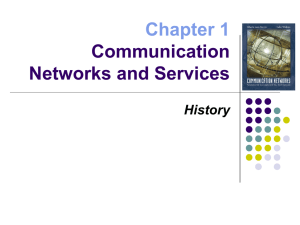Networks and Services
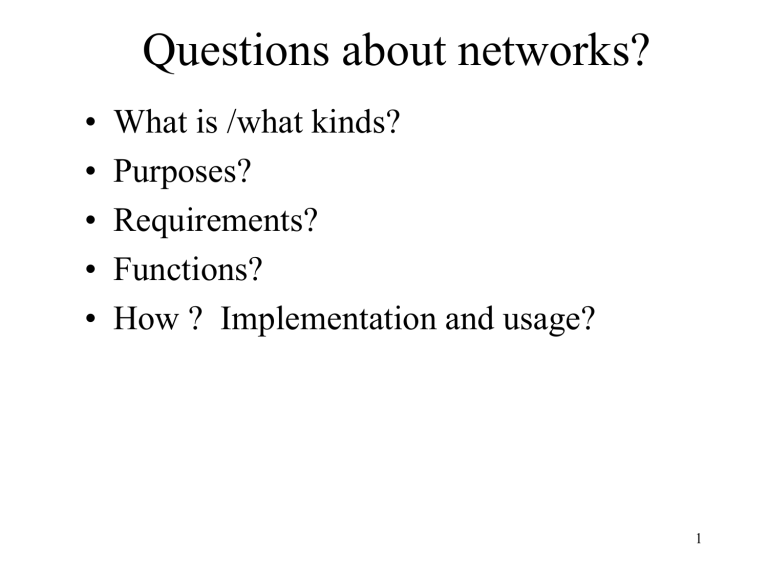
Questions about networks?
• What is /what kinds?
• Purposes?
• Requirements?
• Functions?
• How ? Implementation and usage?
1
Networks and Services
• Communication Networks
• Information Services
• Network Evolution
2
What is a communication network ?
• Infrastructure consisting of equipment & facilities to transfer information between/among users in different locations (telephony, television, cellular,
Internet)
• Like railroads, highways, & airline infrastructures which transport people & goods across space
• Communications networks transport information across space, but
– at the speed of light and at very high rates
• The exchange of information enables interaction at a distance nearly instantaneously
3
Communication Networks VS.
Transportation Networks
• Flow of people & goods
Flow of information
• Flexible interconnectivity&various services (both)
• Roads & highways transmission lines
• Intersections & interchanges switches/routers
• Deciding the route (which exit in an interchange)
routing
• Moving along the route forwarding
• Traffic lights & stop signs flow control
• Road maintenance, detour, …
4
Networks enable services
• Transportation systems enable one basic service
– the transfer of objects, then (built on it)
– postal / passenger / freight service
• Communications networks typically provide a basic information service
– telephony: two-way exchange of voice signals
– voice messaging, fax, modem
– Internet: transfer of information packets
– e-mail, web browsing, e-commerce ...
5
Typical Network Interactions
• Gathering/ Concentration
– this is the traditional interaction model such as
– bill payments / registration
– polling, voting, auctions
• Distribution
– electronic newspaper delivery
– television & radio broadcasting
– mass e- mail.
6
Typical Network Interactions (cont.)
• Request/ Reply (typical client/server model)
– catalog ordering
– Web browsing
• Two & Multi-way Interactive
– telephone (& conferencing)
– video-on-demand
7
Typical services and Requirements
• Radio & television broadcasting, telephone service, cellular telephone service, E-mail, web-browsing, video-on-demand, audiovideo-conferencing
• Delay, reliability of service, accuracy of transmission, volume of information, security and privacy, other specific requirements.
8
Two Examples of Networks & Services
• Telephone Networks were developed solely to provide two-way voice communications
• Internet was developed to provide a basic service
(transfer of packets of information) which would provide a platform for developing many services
–e- mail
– web- browsing
– video streaming
– many variants of e- commerce
9
3.
4.
1.
2.
5.
6.
Telephone
Office
The caller picks up the phone triggering the flow of current in wires that connect to the telephone office.
Telephone
Office
Telephone
Office
Telephone
Office
Telephone
Office
The current is detected and a dial tone is transmitted by the telephone office to indicate that it is ready to receive the destination number.
The caller sends this number by pushing the keys on the telephone set.
Each key generates a pair of tones that specify a number. (In the older phone sets the user dials a number which in turn generates a corresponding number of pulses.)
The equipment in the telephone office then uses the telephone network to attempt a connection. If the destination telephone busy, then a busy tone is returned to the caller. If the destination telephone is idle, then ringing signals are sent to both the originating and destination telephones.
The ringing signals are discontinued when the destination phone is picked up and communication can then proceed.
Telephone
Office
Either of the users terminate the call by putting down a receiver.
Telephone set up and communication
10
Figure 1.1
Requirements for telephone service
• Two-way communication
• Real-time, not much delay
• Reliable connection-oriented
• Voice quality reduces a little (not exact),OK
• Others: connection all the time, security&privacy sometime, 800 calls, caller ID, voice mail, call return, etc.
11
Email service and requirements
Given receiver’s email address, input subject and message, then Click send.
Real time?
NO
Connection-oriented?
Accuracy?
NO
YES
•Delivery confirmation and security and privacy (sometime)
•Others: email reply, email forward, email list, etc
12
1.
2.
3.
4.
5.
6.
Retrieving a web page
The user clicks on a link to indicate which document is to be retrieved.
The browser must determine the address that contains the document. It does this by sending a query to its local name server.
Once the address is known the browser establishes a connection to the specified machine, usually a TCP connection. In order for the connection to be successful, the specified machine must be ready to accept TCP connections.
The browser runs a client version of HTTP, which issues a request specifying both the name of the document and the possible document formats it can handle.
The machine that contains the requested document runs a server version of HTTP. It reacts to the HTTP request by sending an
HTTP response which contains the desired document in the appropriate format.
The TCP connection is then closed and the user may view the document.
13
Figure 1.4
WWW service & requirements
• Not real time, but can not delay too long
• Not only text, but also audio, images
• Dynamic content, links to anywhere
Concepts: HTTP protocol (HyperText Transfer
Protocol)
Client/server model (http client, http server),
URL (Uniform Resource Locator):
(protocol://host:port/file path and file name)
14
Network design and evolution
• Network functions and network topology
• Telegraph network—message switching
• Telephone network—circuit switching
• Computer networks and the Internet--packet switching
17
Network Design
• Applications impose requirements on the services provided by a network
– delay; reliability; accuracy
– volume and rate
– cost & convenience, even security.
• The network design
– meets these requirements cost- effectively
– must address a common set of functions (what?)
– may take fundamentally different approaches
18
Essential Network Functions
• Basic user service
--Voice connections or packet transfer.
• Terminal – the end system that connects to the network, telephone or computer.
• Transmission system – the means for transmitting information across a physical medium: copper telephone wires , coaxial TV cable , optical fiber.
• Information representation – the format of the information handled by the network, voice or bits.
• Addressing – the means for identifying points of connection to the network: telephone number or IP address
19
Essential Network Functions (cont.)
• Routing – the means for determining the path across the network
• Switching/forward approach – the means of transferring information flows between communication lines.
• Multiplexing – the means for connecting multiple information flows into shared connection lines.
• Flow & congest control.
20
t
0
A Network transfers information among users
A single block of information t
1
Network or a stream of information.
21
Figure 1.6
Network Topology:
How a Network Grows
• A network involves the interconnection of transmission lines using switches to convey information among users
• The growth of a network from a few users in close proximity to a very large community over a wide geographic region leads to a hierarchical network structure
22
(a) A switch provides the network to a cluster of users n lines n*(n-1)/2 lines
Network
(b) A multiplexer connects two access networks
Access network
23
Figure 1.7
(a) a
2
3 c
1*
4
A
Metropolitan b d
Metropolitan network A consists of access subnetworks a, b, c, d.
(b) b g a
A
National network consists of regional subnetworks a, b, g
.
Metropolitan network
A is part of regional subnetwork a
.
Hierarchical network topology
24
Figure 1.8
Approaches to Network Design
Function
Basic User
Service
Switching
Approach
Terminal
Telegraph
Network
Transmission of telegrams
Message switching
Telegraph,
Teletype
Telephone
Network
Bi-directional realtime transfer of voice signals
Circuit switching
Telephone, modem
Information representation
Morse, Baudot,
ASCII
Analog voice or
PCM digital voice
Internet
Datagram&reliable stream service between computers
Connectionless packet-switching
Computer
Any binary information
25
Approaches to Network Design (cont.)
Function
Transmission
System
Telegraph
Network
Digital over various media
Telephone
Network
Analog and digital over various media
Internet
Digital over various media
Addressing
Routing
Geographical addresses
Hierarchical numbering plan
Manual routing Route selected during call setup
Hierarchical address space
Each packet routed independently
Circuit multiplexing Packet multiplexing Multiplexing Character and
Message multiplexing
26
Telegraphy Networks & message switching
Samuel B. Morse invented telegraph in 1837
– binary communications using dots & dashes
– Morse code maps alphabet to sequences of dots/ dashes
– text messages transmitted hop- by- hop across a network of relay stations
– Manual routing, routing decision is done by an operator
– Operator stores a message , finds next station according to the destination and forwards it, so message switching
–
Multiplexing, the symbols from several operators into the same communication line.
(20bits/sec 120bits/sec)
27
Morse code
(See Table 1.1 at page 3 or 15)
Letter Code Prob.
Number Code Prob.
A
B
C
D
E
…
.
.-
-…
-.-.
-..
0.081
0.014
0.027
0.039
0.131
1
2
3
4
5
….
.----
..---
…--
….-
…..
T 0.104
28
Telephone networks & circuit switching
1875, Alexander G. Bell invented telephone
• Voice (analog) signal, telephone terminal is very simple, anybody can use it
• Switches were introduced because of the vast cost of dedicated lines (recall n*(n-1) lines to n lines)
• Human operator performs switching, manual routing
• Connection-oriented, dedicated end-to-end connection
(dedicated lines and switches), therefore, circuit switching
• Routing decision at setting up of the connection
29
(a) A switch in the form of an operator with a patch cord panel (not shown)
(b) Cords interconnect user sockets providing end-to-end connection
30
Figure 1.10
Advances of telephone networks
• Digital (0,1) transmission, PCM technique
• Multiplexing: 20 voice calls, 1.5Mbps
• Digital switches
• Hierarchical telephone networks: local/ tandem/toll switches
• Hierarchical numbering (addressing) system: area code + exchange number + phone number
• Automatic connection by computer
• A separate singling network for management
• Enhanced telephone services:credit-card call, long distance call, 800, caller ID, voice mail, cellular phone (mobility).
31
CO: Center Office switch
Tandem switch
Toll switch
Tandem
CO
Toll
CO CO
Tandem
CO
CO
Hierarchical telephone network structure
32
Figure 1.11
Topics discussed (a brief summary)
What is a communication network?
An infrastructure to transfer information over space
What is the purpose of it?
Provides services
What are the main requirements?
Delay, reliability, accuracy
What are four typical interactions?
Gathering, distribution, request/reply, two& multiple way interaction
What does connection-oriented mean?
A connection between two parties must be set up ahead of information transmission
33
Topics discussed (
a brief summary—cont.
)
What are the main network functions?
Switching, information representing, addressing, routing, multiplexing
What are approaches implementing the functions?
In telegraph networks:
Message switching, Morse code, geographical address, manual routing, char&message multiplexing
In telephone networks:
Circuit switching, analog or digital, hierarchical numbering, call setup manually/automatically, circuit multiplexing
What is the generic network topology?
Hierarchical network structure
34
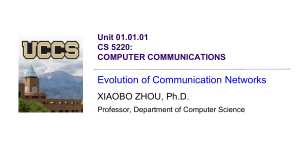



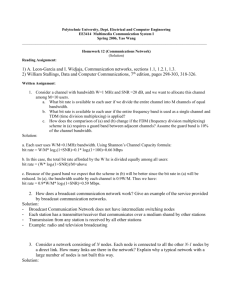

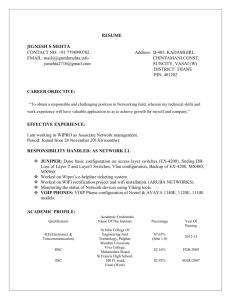
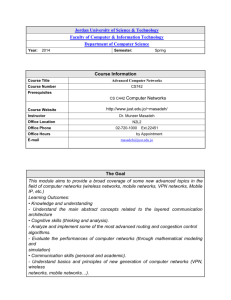
![Network Technologies [Opens in New Window]](http://s3.studylib.net/store/data/008490270_1-05a3da0fef2a198f06a57f4aa6e2cfe7-300x300.png)

